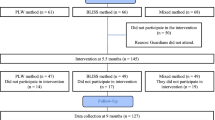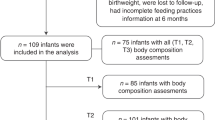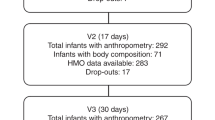Abstract
Background/Objectives:
Few studies have examined the factors explaining the variability in fat and carbohydrate intake during infancy. We aimed to describe infants’ fat and carbohydrate intake and analyse the associations with infant and maternal characteristics and feeding practices.
Subjects/Methods:
This study included 1275 infants aged 8 months from the French EDEN mother–child cohort. Carbohydrate intake, fat intake, added fat (vegetable oils and animal fats) and added sugar (honey, white sugar, brown sugar, jam and sweetened beverages) consumption were calculated at 8 and 12 months. Associations between these variables and infant and maternal characteristics as well as maternal dietary patterns during pregnancy, breast-feeding duration and age at complementary feeding introduction were analysed using multivariable linear and logistic regressions.
Results:
Less than 5% of non-breast-fed infants reached the recommendation of consuming at least 40% of total energy from fat, whereas more than 95% of them reached 45% of energy from carbohydrates. Overall, infant and maternal characteristics and maternal diet during pregnancy were marginally associated with both carbohydrate/added sugar and fat/added fat intake. Nevertheless, age at complementary feeding introduction was associated with all outcomes.
Conclusions:
Our results suggest that only a small proportion of non-breast-fed infants at 8 and 12 months reached the recommendations for fat intake, whereas a majority of them reached the recommendations for carbohydrate intake. As subgroups of infants with a higher risk of inadequate diet were not identified, the present results call for an improved dissemination of information regarding infant-specific dietary fat needs in the entire population.
This is a preview of subscription content, access via your institution
Access options
Subscribe to this journal
Receive 12 print issues and online access
$259.00 per year
only $21.58 per issue
Buy this article
- Purchase on Springer Link
- Instant access to full article PDF
Prices may be subject to local taxes which are calculated during checkout

Similar content being viewed by others
References
Food and Agriculture Organization of the United Nations (FAO). Fats and fatty acids in human nutrition. Report of an expert consultation. Guideline 2010; 91: 1–166.
Uauy R, Dangour AD . Fat and fatty acid requirements and recommendations for infants of 0-2 years and children of 2-18 years. Ann Nutr Metab 2009; 55: 76–96.
EFSA Panel on Dietetic Products N, and Allergies (NDA). Scientific opinion on dietary reference values for fats, including saturated fatty acids, polyunsaturated fatty acids, monounsaturated fatty acids, trans fatty acids, and cholesterol. EFSA J 8: 1461.
Rolland-Cachera MF, Maillot M, Deheeger M, Souberbielle JC, Peneau S, Hercberg S . Association of nutrition in early life with body fat and serum leptin at adult age. Int J Obes 2013; 37: 1116–1122.
Rolland-Cachera MF, Deheeger M, Akrout M, Bellisle F . Influence of macronutrients on adiposity development: a follow up study of nutrition and growth from 10 months to 8 years of age. Int J Obes Relat Metab Disord 1995; 19: 573–578.
Scaglioni S, Agostoni C, De Notaris R, Radaelli G, Radice N, Valenti M et al. Early macronutrient intake and overweight at five years of age. Int J Obes 2000; 24: 777–781.
Stephen A, Alles M, de Graaf C, Fleith M, Hadjilucas E, Isaacs E et al. The role and requirements of digestible dietary carbohydrates in infants and toddlers. Eur J Clin Nutr 2012; 66: 765–779.
Food and Agriculture Organization of the United Nations (FAO). Carbohydrates in human nutrition. Report of a Joint FAO/WHO Expert Consultation. Congresses. FAO Food and Nutrition Paper No. 66 Food and Agriculture Organization of the United Nations: Rome, 1998.
World Health Organization (WHO). Diet, nutrition and the prevention of chronic diseases. report of a joint WHO/FAO expert consultation, Geneva: WHO technical report series. 916 2003.
Mann J, Cummings JH, Englyst HN, Key T, Liu S, Riccardi G et al. FAO/WHO scientific update on carbohydrates in human nutrition: conclusions. Eur J Clin Nutr 2007; 61: S132–S137.
EFSA Panel on Dietetic Products NaA. Scientific opinion on dietary reference values for carbohydrates and dietary fibre. EFSA J 2010; 8: 14–62.
World Health Organization (WHO). Guideline: sugars intake for adults and children. Geneva: World Health Organization, 2015.
Kiefte-de Jong JC, de Vries JH, Bleeker SE, VWV Jaddoe, Hofman A, Raat H et al. Socio-demographic and lifestyle determinants of 'Western-like' and 'Health conscious' dietary patterns in toddlers. Br J Nutr 2013; 109: 137–147.
Bell LK, Golley RK, Daniels L, Magarey AM . Dietary patterns of Australian children aged 14 and 24 months, and associations with socio-demographic factors and adiposity. Eur J Clin Nutr 2013; 67: 638–645.
Okubo H, Miyake Y, Sasaki S, Tanaka K, Murakami K, Hirota Y et al. Dietary patterns in infancy and their associations with maternal socio-economic and lifestyle factors among 758 Japanese mother-child pairs: the Osaka Maternal and Child Health Study. Matern Child Nutr 2014; 10: 213–225.
Robinson S, Marriott L, Poole J, Crozier S, Borland S, Lawrence W et al. Dietary patterns in infancy: the importance of maternal and family influences on feeding practice. Br J Nutr 2007; 98: 1029–1037.
Smithers LG, Brazionis L, Golley RK, Mittinty MN, Northstone K, Emmett P et al. Associations between dietary patterns at 6 and 15 months of age and sociodemographic factors. Eur J Clin Nutr 2012; 66: 658–666.
Brazionis L, Golley RK, Mittinty MN, Smithers LG, Emmett P, Northstone K et al. Characterization of transition diets spanning infancy and toddlerhood: a novel, multiple-time-point application of principal components analysis. Am J Clin Nutr 2012; 95: 1200–1208.
Lioret S, Betoko A, Forhan A, Charles MA, Heude B, de Lauzon-Guillain B et al. Dietary patterns track from infancy to preschool age: cross-sectional and longitudinal perspectives. J Nutr 2015; 145: 775–782.
Lioret S, McNaughton SA, Spence AC, Crawford D, Campbell KJ . Tracking of dietary intakes in early childhood: the Melbourne InFANT Program. Eur J Clin Nutr 2013; 67: 275–281.
dos Santos Barroso G, Sichieri R, Salles-Costa R . Relationship of socio-economic factors and parental eating habits with children's food intake in a population-based study in a metropolitan area of Brazil. Public Health Nutr 2014; 17: 156–161.
Briefel R, Ziegler P, Novak T, Ponza M . Feeding infants and toddlers study: characteristics and usual nutrient intake of hispanic and non-hispanic infants and toddlers. J Am Diet Assoc 2006; 106: S84–S95.
Gatica G, Barros AJ, Madruga S, Matijasevich A, Santos IS . Food intake profiles of children aged 12, 24 and 48 months from the 2004 Pelotas (Brazil) birth cohort: an exploratory analysis using principal components. Int J Behav Nutr Phys Act 2012; 9: 43.
Aranceta J, Perez-Rodrigo C, Ribas L, Serra-Majem L . Sociodemographic and lifestyle determinants of food patterns in Spanish children and adolescents: the enKid study. Eur J Clin Nutr 2003; 57: S40–S44.
Dubois L, Farmer A, Girard M, Burnier D, Porcherie M . Demographic and socio-economic factors related to food intake and adherence to nutritional recommendations in a cohort of pre-school children. Public Health Nutr 2011; 14: 1096–1104.
Kranz S, Siega-Riz AM . Sociodemographic determinants of added sugar intake in preschoolers 2 to 5 years old. J Pediatr 2002; 140: 667–672.
North K, Emmett P . Multivariate analysis of diet among three-year-old children and associations with socio-demographic characteristics. The Avon Longitudinal Study of Pregnancy and Childhood (ALSPAC) Study Team. Eur J Clin Nutr 2000; 54: 73–80.
Northstone K, Emmett P . Multivariate analysis of diet in children at four and seven years of age and associations with socio-demographic characteristics. Eur J Clin Nutr 2005; 59: 751–760.
Heude B, Forhan A, Slama R, Douhaud L, Bedel S, Saurel-Cubizolles MJ et al. Cohort Profile: The EDEN mother-child cohort on the prenatal and early postnatal determinants of child health and development. Int J Epidemiol 2015; 45: 353–363.
ANSES. French food composition table [internet] France: French Agency for Food, Environmental and Occupational Health & Safety (ANSES); 2015; Available at: https://pro.anses.fr/tableciqual/index.htm (accessed 05 November 2015).
Deschamps V, de Lauzon-Guillain B, Lafay L, Borys JM, Charles MA, Romon M . Reproducibility and relative validity of a food-frequency questionnaire among French adults and adolescents. Eur J Clin Nutr 2009; 63: 282–291.
Thiebaut A, Kesse E, Com-Nougue C, Clavel-Chapelon F, Benichou J . Ajustement sur l'apport energetique dans l'evaluation des facteurs de risque alimentaires (Adjustment for energy intake in the assessment of dietary risk factors). Rev Epidemiol Sante Publique 2004; 52: 539–557.
Willett W, Stampfer MJ . Total energy intake: implications for epidemiologic analyses. Am J Epidemiol 1986; 124: 17–27.
Fantino M, Gourmet E . Apports nutritionnels en France en 2005 chez les enfants non allaites ages de moins de 36 mois (Nutrient intakes in 2005 by non-breast fed French children of less than 36 months). Arch Pediatr 2008; 15: 446–455.
Koletzko B, Dokoupil K, Reitmayr S, Weimert-Harendza B, Keller E . Dietary fat intakes in infants and primary school children in Germany. Am J Clin Nutr 2000; 72: 1392S–1398SS.
Michaelsen KF . Nutrition and growth during infancy. The Copenhagen Cohort Study. Acta Paediatr Suppl 1997; 420: 1–36.
Conn JA, Davies MJ, Walker RB, Moore VM . Food and nutrient intakes of 9-month-old infants in Adelaide, Australia. Public Health Nutr 2009; 12: 2448–2456.
Grote V, Verduci E, Scaglioni S, Vecchi F, Contarini G, Giovannini M et al. Breast milk composition and infant nutrient intakes during the first 12 months of life. Eur J Clin Nutr 2016; 70: 250–256.
Emmett PM, Jones LR . Diet and growth in infancy: relationship to socioeconomic background and to health and development in the Avon Longitudinal Study of Parents and Children. Nutr Rev 2014; 72: 483–506.
Cooke LJ, Wardle J . Age and gender differences in children's food preferences. Br J Nutr 2005; 93: 741–746.
Vauthier JM, Lluch A, Lecomte E, Artur Y, Herbeth B . Family resemblance in energy and macronutrient intakes: the Stanislas Family Study. Int J Epidemiol 1996; 25: 1030–1037.
Lioret S, Cameron AJ, McNaughton SA, Crawford D, Spence AC, Hesketh K et al. Association between maternal education and diet of children at 9 months is partially explained by mothers' diet. Matern Child Nutr 2013; 11: 936–947.
Smithers LG, Golley RK, Brazionis L, Emmett P, Northstone K, Lynch JW . Dietary patterns of infants and toddlers are associated with nutrient intakes. Nutrients 2012; 4: 935–948.
Elliott CD . Sweet and salty: nutritional content and analysis of baby and toddler foods. J Public Health 2011; 33: 63–70.
van den Boom S, Kimber AC, Morgan JB . Nutritional composition of home-prepared baby meals in Madrid. Comparison with commercial products in Spain and home-made meals in England. Acta Paediatr 1997; 86: 57–62.
Beauchamp GK, Moran M . Dietary experience and sweet taste preferences in human infants. Appetite 1982; 3: 139–152.
Beauchamp GK, Moran M . Acceptance of sweet and salty tastes in 2-year-old children. Appetite 1984; 5: 291–305.
Schwartz C, Scholtens P, Lalanne A, Weenen H, Nicklaus S . Development of healthy eating habits early in life. Review of recent evidence and selected guidelines. Appetite 2011; 57: 796–807.
Acknowledgements
We are indebted to the participating families, the midwife research assistants (Lorraine Douhaud, Sophie Bedel, Brigitte Lortholary, Sophie Gabriel, Muriel Rogeon and Monique Malinbaum) for data collection, and Patricia Lavoine, Josiane Sahuquillo and Ginette Debotte for checking, coding and data entry. The EDEN mother–child cohort study group includes I Annesi-Maesano, JY Bernard, J Botton, MA Charles, P Dargent-Molina, B de Lauzon-Guillain, P Ducimetière, M de Agostini, B Foliguet, A Forhan, X Fritel, A Germa, V Goua, R Hankard, B Heude, M Kaminski, B Larroque, N Lelong, J Lepeule, G Magnin, L Marchand, C Nabet, F Pierre, R Slama, MJ Saurel-Cubizolles, M Schweitzer and O Thiebaugeorges. We thank the Information Centre on Food Quality (CIQUAL), unit of ANSES (French agency for food and environmental and occupational health safety) and the French baby foods industry group (SFAE) for providing, respectively, the 2006 French food composition database and the 2005 French baby foods composition database. Supported by grant from the Didit métaprogramme of INRA (‘SweetLip-kid’ project to SN; doctoral fellowship to WLY). The EDEN cohort study is supported by Foundation for Medical Research (FRM), National Agency for Research (ANR), National Institute for Research in Public Health (IRESP: TGIR cohorte santé 2008 programme), French Ministry of Health (DGS), French Ministry of Research, Inserm Bone and Joint Diseases National Research (PRO-A) and Human Nutrition National Research Programmes, Paris–Sud University, Nestlé, French National Institute for Population Health Surveillance (InVS), French National Institute for Health Education (INPES), the European Union FP7 programmes (FP7/2007-2013, HELIX, ESCAPE, ENRIECO, Medall projects), Diabetes National Research Programme (through a collaboration with the French Association of Diabetic Patients (AFD)), French Agency for Environmental Health Safety (now ANSES), Mutuelle Générale de l’Education Nationale (MGEN), French National Agency for Food Security and the French-speaking association for the study of diabetes and metabolism (ALFEDIAM). Funders had no influence of any kind on analyses or result interpretation.
Author contributions
The authors’ responsibilities were as follows—The EDEN mother–child cohort study group, coordinated by BH, was responsible for study design and data collection. BLG and SN were involved in all aspects from study conception to manuscript writing. WLY and AF participated in data management for the present analysis. WLY analysed and interpreted the data and wrote the initial draft of the manuscript. SN, SL, CL, BH, MAC and BLG critically reviewed all sections of the text for important intellectual content. All authors had full access to all of the data in the study and can take responsibility for the integrity of the data and the accuracy of the data analysis. All authors read and approved the final manuscript.
Author information
Authors and Affiliations
Consortia
Corresponding author
Ethics declarations
Competing interests
The authors declare no conflict of interest.
Additional information
Supplementary Information accompanies this paper on European Journal of Clinical Nutrition website
Supplementary information
Rights and permissions
About this article
Cite this article
Yuan, W., Nicklaus, S., Lioret, S. et al. Early factors related to carbohydrate and fat intake at 8 and 12 months: results from the EDEN mother–child cohort. Eur J Clin Nutr 71, 219–226 (2017). https://doi.org/10.1038/ejcn.2016.216
Received:
Revised:
Accepted:
Published:
Issue Date:
DOI: https://doi.org/10.1038/ejcn.2016.216
This article is cited by
-
A network analysis of nutritional markers and maternal perinatal mental health in the French EDEN cohort
BMC Pregnancy and Childbirth (2023)
-
Macronutrient intake during infancy and neurodevelopment in preschool children from the EDEN mother–child cohort
European Journal of Clinical Nutrition (2023)
-
Maternal Diet During Pregnancy and Lactation and Child Food Preferences, Dietary Patterns, and Weight Outcomes: a Review of Recent Research
Current Nutrition Reports (2021)



